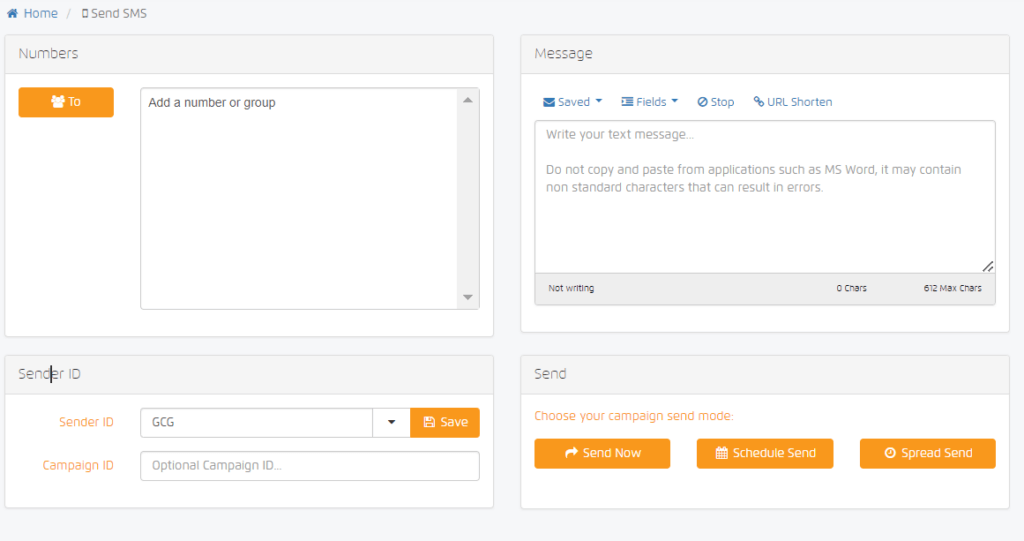
Bulk SMS 101: What it is & how to send messages

If you want to spread the word quickly, bulk SMS is the best way to do it.
In this guide, you’ll find out why. And learn everything you need to know to send your first messages.

What is Bulk SMS?
Bulk SMS is the distribution of text messages to multiple people. It’s a fast and effective way to reach a large audience with updates, offers, reminders, and more.
You’ll often see the term ‘bulk SMS’ used interchangeably with ‘SMS marketing.’
SMS marketing is the practice of sending marketing messages to customers via SMS. Bulk SMS is the best way to do SMS marketing because it lets you reach everyone in your contact list in seconds.
So, it’s most popular with businesses and consumer brands looking to engage customers, get sales and improve their overall marketing performance (more about why SMS helps with these things soon).
If you’ve ever received a special offer from a business you’ve used in the past, that’s bulk SMS for marketing in action.
But bulk SMS is more than a sales tactic. If you’ve ever received a generic text message update from your school, energy provider or HMRC, for example, that’s also bulk SMS in action.
Additionally, bulk SMS can be used to share announcements and updates with employees or between colleagues.
In short, it’s a great way to reach a lot of people, whatever the reason.

How does Bulk SMS work?
Bulk SMS is sent using a bulk SMS platform (like Text Marketer).
The platform uses an SMS gateway to let you send text messages from a website app on your computer or mobile device
It also gives you features you won’t find on a phone messaging app, like the ability to:
- Upload contact lists from a spreadsheet
- Group contacts for different campaigns
- Personalise text messages with details like name, company and account number
- Add short links
- Receive SMS replies
- View delivery reports
- Schedule messages
- Create SMS web pages
- Add additional users
Here’s how our bulk SMS platform looks:

As you can see, it’s more of a content editor than a messaging app—designed to make creating and sending messages easy.
To send a text, you need credits. One credit equals one text (a 160-character message), unless you’re sending to a non-UK number. In this case, two credits equal one text.
If you’re sending more than a few hundred messages a day, you also need a short code.
This is a five-digit number pre-approved by mobile carriers and not subject to filtering in the same way as a long code (a standard 11-digit number).
In other words, they stop your messages being labelled as spam.
Here’s how Cancer Research uses short codes to make it easy for people to donate:
Your short code (or long code) acts as a Sender ID to show recipients who the text is from.
It can also pair with an SMS keyword of your choosing (subject to availability). Cancer Research, for example, uses the keyword “RACE10” for Race for Life Donations.
When you hit send on a text message, the SMS gateway translates it into a format mobile devices can recognise and routes it (in the case of Text Marketer at least) via Tier 1 SMS connections to mobile networks, to the recipient’s phone. This all happens in seconds.
A tier 1 connection (or tier 1 aggregator) connects directly to mobile networks. Some tier 2 connections, on the other hand, use grey routes that route via third-party countries, thus making sending a bit more unreliable.
Simply put: tier 1 connections take the fastest route. Tier 2 connections take the scenic route.
Some bulk SMS platforms also offer an SMS API that lets you connect to a content management system or sales tool, so you can pull in data from other sources to automate some of your marketing.
Say you sell products via your website. With an SMS API, you can set up order confirmation texts to automatically send whenever a customer completes a purchase.
You can do the same for any repetitive text message: abandoned cart reminders, birthday messages, customer feedback, and more.
Additionally, some APIs feature Email to SMS. This does exactly as the name suggests: lets you send text messages via your email account. When you hit send, the SMS gateway does its thing.
It’s a good option if you’re more comfortable working from your inbox.

The two types of Bulk SMS messages
Broadly speaking, bulk SMS messages fall into one of the two categories:
1. Transactional SMS
Transactional text messages are used to share important non-promotional information. Common examples include:
- Order status
- Tracking details
- Password information
- Travel updates
- Service updates
- Customer surveys
- Appointment reminders
- Payment reminders
- Welcome messages
- Customer support
Here’s an example of a transactional customer support message from the AA:
The majority of the bulk SMS messages you send will be transactional. Or they should be.
78% of mobile users say they will read a text message from a company they know and have given their number to. But no one wants to be sold to all the time.
40% of respondents to a State of SMS Marketing Report by Validity say they are often or constantly annoyed by SMS marketing messages.
So, it’s important to get the balance right. A transactional text is never annoying, because it shares information a customer needs.
Transactional SMS can be conversational or informational.
Conversational messages are back-and-forth exchanges.
The customer can start the conversation. For example, they text a customer service number they see on your website and you reply.
Or you can start it. For example, you send an SMS survey asking a customer to rate their recent service and they reply.
Informational messages are typically one-way.
This might be you sending a one-off response. For example, a one-time password when a customer logs in to their account.
Or sending a no-reply text. For example, a payment reminder or service update to an existing customer.
2. Promotional SMS
Promotional text messages are used for marketing and advertising when you want to generate engagement, get leads or make sales.
Common examples include:
- Special offers
- Discount codes
- Sales alerts
- Competition or giveaways
- Upsell and cross-sell messages
- Cart abandonment texts
- Birthday or anniversary texts
Here’s an example from AO:
As mentioned, promotional messages should be few and far between to avoid annoying customers.
Making around 20% of your bulk SMS campaigns promotional and the rest transactional is the general rule of thumb.
Check out some examples of transactional and promotional SMS in our guide to SMS Marketing.

The benefits of Bulk SMS
We said at the top that bulk SMS is the best way to spread the word quickly. Here’s why:
High engagement rates
Engagement rate is a metric that measures how many people interact with your messaging.
With bulk SMS, like email, it’s measured by:
- Open rate. The number of people who open an SMS
- Click-through rate. The number of people who click a link in an SMS
- Response rate. The number of people who reply to an SMS
The higher these numbers are, the more effective your marketing or messaging is. This leads to:
- Greater visibility
- Stronger brand affinity
- Increased trust
- More referrals
- Better relationships with customers
And all of those things can lead to more sales. SMS has a conversation rate of 29%, which is nearly double that of email (15.22%).
The reason the conversion rate is so high is because the engagement metrics of SMS are so high.
- SMS marketing texts have an average open rate of 98%
- SMS marketing texts have an average click-through rate of 28-33%
- SMS marketing texts have a response rate of 45%
In terms of benchmarks, no other channel comes close.
The open rate for email marketing sits at 21%, with a click-through rate of 6%. The click-through rate for social media advertising is 0.98%.
This isn’t to say you shouldn’t use email or social ads. Both can work well in strategy alongside bulk SMS. But if you want attention and clicks, bulk SMS is your best bet.
High Return on Investment (ROI)
The high engagement of bulk SMS, paired with its affordability, means it can offer good bang for your buck.
You can send texts for as little as 3.4p per text (less if you take advantage of introductory double points offers).
This keeps marketing costs low and can increase your net profit.
As an example, pizza restaurant Papa John’s used Text Marketer to send an offer to 8100 customers. The result?
£5.30 generated for every £1 spent. That’s an ROI of 430% (ROI = Net Profit / Cost of Investment x 100%). And a 33% increase in average weekly takings.
Wide accessibility
Another reason for those high SMS engagement rates is wide reach. 93% of UK households own a mobile phone.
Although most are smartphones (98% of UK adults aged 16-24 have a smartphone), one of the great things about bulk SMS is that a phone only requires a working SIM card to receive texts.
It means a device doesn’t have to be smart and an internet connection isn’t required. Making SMS accessible to more people than email marketing or social media marketing.
Plus, receiving a text is familiar and straightforward. SMS marketing has been used for over two decades. And most people prefer it.
76% of Millennials say texts are less disruptive than a phone call. 75% say they’d rather lose the ability to talk versus text.
Recipients aren’t required to log in to an app to view texts. And when they’re checking their phones every 12 minutes of the waking day on average, your message is never far from view.
Easy personalisation
Personalised marketing involves making messages unique to each customer, using data you’ve collected from them, such as:
- Name
- Company name
- Location
- Date of birth
- Purchase history
- Customer details (account details, purchase information, etc.)
It plays an important role in successful marketing, as noted in our SMS marketing guide:
- 71% of consumers expect personalisation
- 76% get frustrated when they don’t get it
Giving customers what they want can boost your business. 90% of leading marketers say personalization significantly contributes to business profitability. And companies that are good at it earn 40% more money than the average competitor.
Simply put: if you’re going to be using bulk SMS for promotion, personalisation is essential.
That said, it’s good business, even if your intended use is purely transactional.
A personalised text lets you connect with people on a more personal level, helping to build trust and strengthen relationships. It tells recipients they’re more than just a number.
One of the biggest benefits of bulk SMS is that it makes personalisation simple. How?
Merge tags.
Merge tags are labels that inject personalisation into a text message in a couple of clicks.
For example, you can insert:
- First Name
- Surname
- Company name
- City
- Country
- And more
The label is automatically translated into personalised information.
For instance, if you select ‘First Name’ your text, once sent, will automatically include the name attached to the recipient’s contact number. So where you see, “Hi [First Name],” they see “Hi David,”.
Not only is this a massive time saver, it means you can send thousands of individual texts, rather than one generic bulk message to thousands of people.
Built for beginners
If you can send a text, you can send a bulk text message. Format and character limits are the same. And platforms are beginner-friendly.
Take Steve Hallet, a store manager for Bathstore. He was able to sign up for an account and send his first bulk SMS campaign within five minutes.
Even more advanced features like SMS web pages (the SMS version of website landing pages) are straightforward regardless of tech expertise:
“[SMS Web Pages] was really simple to get to grips with, it took me less than 15 minutes to master it, adding various images, text and a call to action button.
“I really like how when you create your page, you can then change the layout and all the images and text stay on the page, meaning I didn’t have to start again if I wanted a different layout.” – Star Cars Birmingham
Once you’ve signed up and bought credits, getting started is fuss-free. Here’s the four-step process for sending your first bulk SMS on Text Marketer:
1. Upload a new list from a spreadsheet (CSV file)
2. Enter your sender details (e.g. your company name) or choose a reply number
3. Write your SMS and personalise it with customer details (e.g. name or company)
4. Hit ‘Send now’, or choose to schedule or drip feed your SMS
While we can’t speak for other platforms being straightforward, you likely won’t have much of a learning curve to contend with.

How to send Bulk SMS messages
We’ve just covered the steps for sending a bulk SMS using Text Marketer, but let’s dig deeper into what’s required to run a campaign that gets people opening, clicking and responding.
1. Learn the rules (and follow them)
Bulk SMS is regulated by several data protection and privacy laws:
- The Data Protection Act 2018
- General Data Protection Regulation (GDPR)
- Privacy and Electronic Communications Regulations (PECR)
- Information Commissioner’s Office (ICO)
- Advertising Standards Authority
You need to understand and comply with these regulations to avoid a ban on sending SMS and a potential six-figure fine.
We’ve covered the do’s and don’ts in the ‘Is SMS Marketing legal?’ section of our SMS marketing guide. But as a brief overview, here’s what you need to do to stay compliant:
1. Get consent before sending an SMS
2. Make it easy for people to opt-out and promptly process requests
3. Clearly share your identity in text messages so the recipient knows it’s you
4. Do not send promotional messages after 8:00 pm or before 9:00 am
2. Grow your contact list
Your contact list is everyone who’s opted-in to receive your SMS.
The opt-in part is important as it’s where you secure consent. It stops you from breaking the rules and ensures you’re contacting people who are interested in what you have to say.
To grow your list, give people a reason to sign up. Here are some ideas:
- Run a competition and promote it on your website and marketing channels
- Invite website visitors to a VIP club
- Use incentives (e.g. discount codes or free swag) on website forms
- Promote subscriber benefits on social media
- Include a keyword and short code (e.g. “Text START to 12345”) in emails and presentations
iRadio, for example, uses its radio shows and social channels to promote its cash giveaways:
Entrants are added to iRadio’s customer database to receive SMS messages.
When securing opt-in, always remember to include instructions on how to opt-out. This should be in your terms and conditions and texts, as per the rules for SMS marketing.
3. Choose a Bulk SMS platform
The right platform will make sending texts and measuring performance easy.
Each one has pros and cons to consider. Here are some questions to ask as you compare options:
- Are bulk credits affordable?
- Are editing tools easy to use?
- Does it include compliance features?
- Can you create contact groups to segment customers?
- Does it use tier 1 network connections?
- Can you personalise text messages?
- Can you buy extra keywords?
- Does it include a URL shortener?
- Does it have autoresponders?
- Does it include analytics?
- Can you add sub-accounts?
- Does it rate high on customer support?
If the answer to each of these questions is yes, you’re onto a winner.
4. Write engaging text messages
An SMS limits you to 160 characters. Going over that means using extra credits, so it pays to embrace those constraints.
Plus, the quicker you get your message across, the more likely it is you’ll get a response. SMS isn’t a channel for unnecessary wordiness.
Here are some tips for writing engaging texts:
- Keep it short and simple. Stick to one idea and express it as clearly as possible. Use short sentences and simple language. Avoid jargon or unnecessary abbreviations.
- Make it relevant. Always meet a subscriber’s needs. Segment contacts into groups based on demographics like location, age and purchase history so what they see makes sense.
- Add personalisation. Include data such as name, date, location, birthdays and special reminders to add an extra human touch.
- Include a clear call to action (CTA). Tell customers exactly what you want them to do next. Add instructions or a link to help them do it.
- Don’t skip the opt-out. We’ve said it already, but it bears repeating. Including a simple opt-out will protect your reputation.
Want some inspiration? Check out over 50+ SMS examples in our Message Template Library.
5. Hit send (but do it at the right time)
If your message is urgent (e.g. a service issue, security information, or time-sensitive offer), send it immediately.
If not, think more carefully about timing.
For example, if you’re sending an internal message, it’s likely to perform better during work hours.
But if you’re running a limited-time deal, it might be better to send a message outside of work hours when subscribers are more likely to be using their phones.
You’ll also want to think about demand. If you’re sending a special code to 20,000 people, do you have the resources to ensure you can fulfil orders?
As well as ‘Send Now’, a bulk SMS platform will give you the option to:
- Schedule: Choose a time in the future to send your text
- Spread send: Drip feed your text over a period of time (e.g. 8 hours)
Timing is something you’ll improve as data rolls in and you begin to gauge effectiveness. Until then, pick a time that makes sense and experiment around it.
6. Track results to improve future campaigns
Once your text begins pinging subscriber’s phones, you can use analytics to see how it’s performing.
Look at:
Delivery reports
These tell you how many messages were sent, how many were delivered and how many failed.
There are several reasons why a message can fail to send:
- Invalid number
- Signal issues
- Device is switched off
- Sender ID is accidentally blocked
- Phone memory issues
If it happens more than once, remove the contact. It’s a simple way to refine your list and save on wasted credits.
Received messages
This lets you see how people are engaging with your texts and whether they’re opting out.
By experimenting with times and viewing replies, you’ll get an idea of when your audience is most responsive.
The same goes for messaging. If a particular message has a better response rate, examine the copy and CTA to see which elements you can replicate in future messages.
Don’t get too hung up on opt-out responses. Instead, use them to refine your lists and improve your messaging.
Track results for current campaigns to fine-tune the next.
Run your first bulk SMS campaign
Now you know what all the fuss is about, it’s time to put your knowledge into practice:
- Use your website and marketing channels to grow your list
- Sign up to a bulk SMS platform like Text Marketer to create campaigns
- Optimise your messages using the best practices in this post
Before long, you should see bulk SMS become a top communication method and a profitable marketing tactic.


